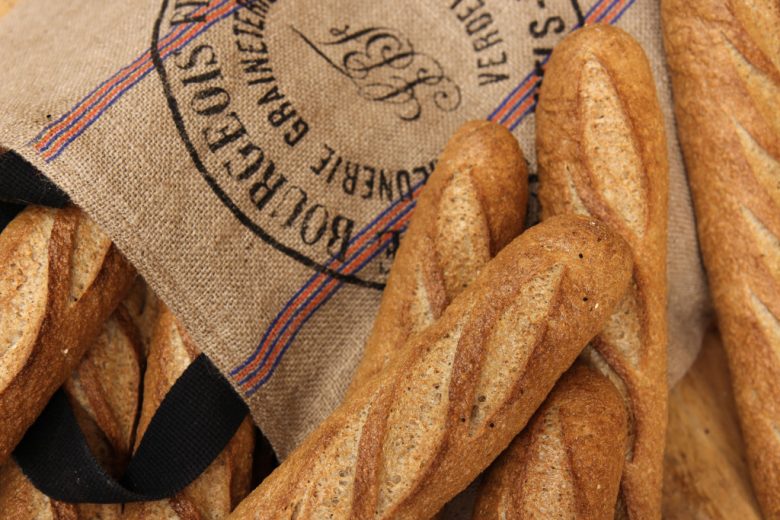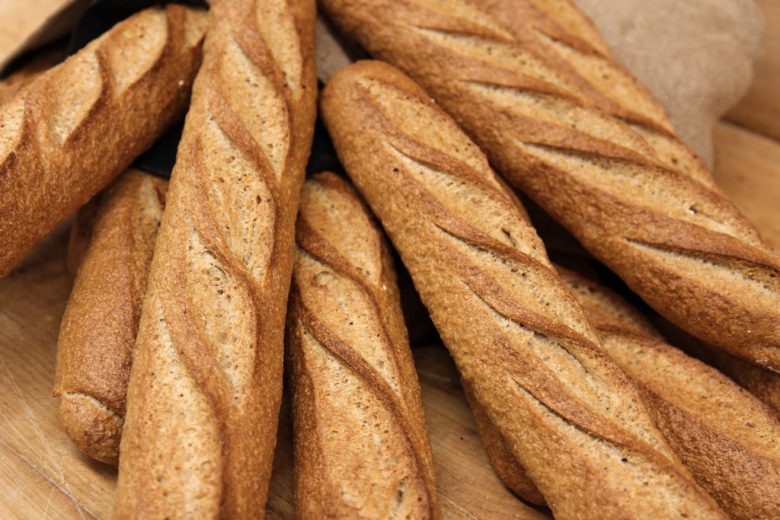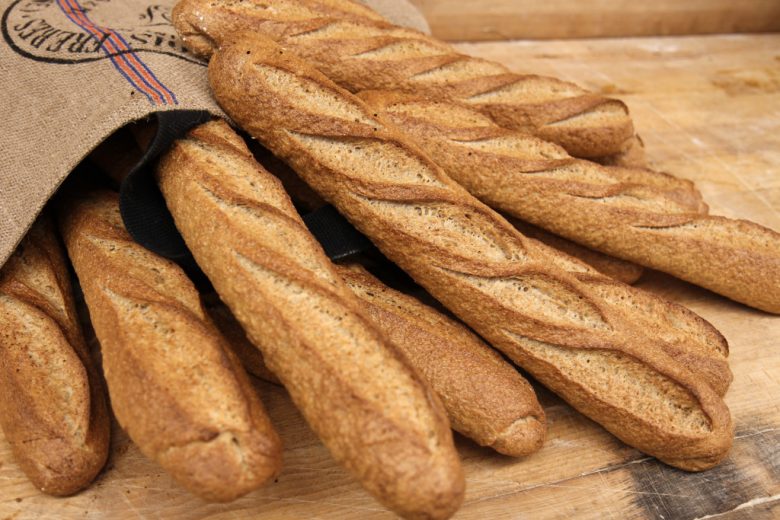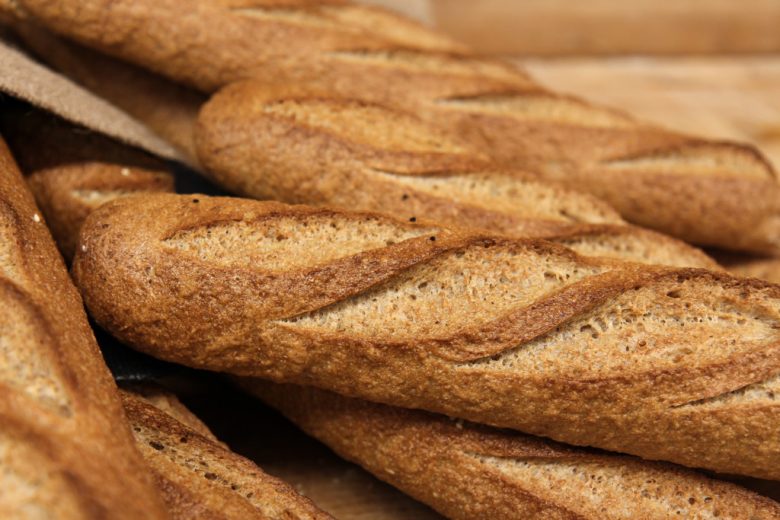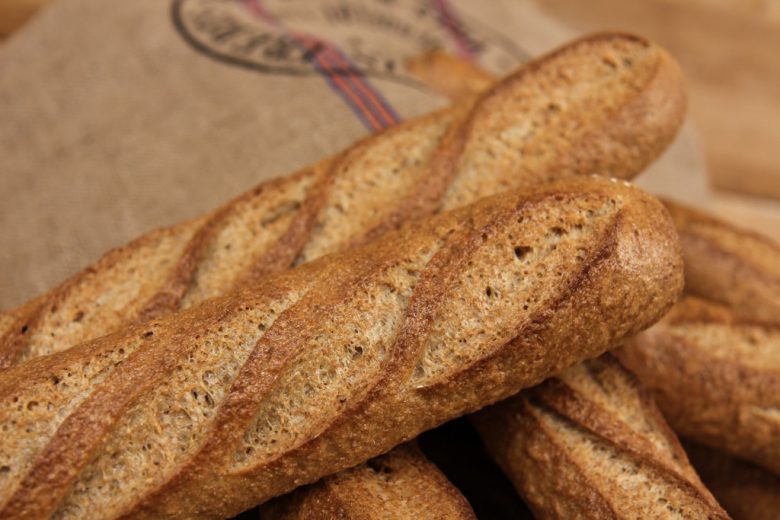Wholegrain Spelt Baguettes
Whole Grain Spelt Baguettes are easy to make, even for beginners. The main dough consists of a poolish (for the taste) and a water-roux (for shelf life). The recipe’s only challenging part is ensuring you add the exact amount of liquid to the dough. Water absorption can vary due to the differences in the grind of the bran, which is why I recommend precisely observing the start of the mixing process when working with new whole grain recipes.
How dough consistency affects bread quality:
Dough too stiff:
- Small, squat volume
- Insufficient relaxation (dense crumb)
- Stiff crumb
- Crumbly crumb
- Poor shelf life
Dough too soft:
- Flat shape (Bread and rolls expand horizontally while baking)
- Tough crumb
- Leathery and soft crust
Correct kneading of (whole grain) spelt doughs:
You recognize overkneaded dough by:
- The dough surface beginning to shine
- The dough itself becoming sticky and increasingly moist
This is why the basic principle of spelt is: KNEAD SLOWLY!
If, despite being careful, a dough becomes overkneaded, I recommend the following procedure: To somewhat rebuild dough stability, place the dough in the fridge for 30 minutes. Then stretch it once and return to the fridge for 30 more minutes. This stabilizes the dough structure, making it better to work with.
In contrast, an underkneaded dough’s gluten structure is inelastic. This becomes noticeable when working with the dough post-rise in that it seems “stubborn.” Insufficient bloom and a tough crust are effects that are manifested during baking.
Dough rests and rises with spelt baked goods:
- A main factor in the dough rise is the predough amount! The more predough is in the main dough, the shorter the dough rests can be.
- Dough temperature: the cooler the dough temperature, the longer the dough rise lasts (Careful: Don’t go above 27°C).
- Added yeast: (a little yeast / longer rise time and lots of yeast / shorter rise time)
- Dough consistency: Soft doughs need more time to rise. Stiff doughs complete their rise more quickly – the reason is better development of the dough during the mixing and kneading phases.
- Added honey or sugar: Adding in 3% of either speeds up the dough rise (larger quantities minimize dough rise)
Soaked doughs
Making soaked doughs (autolyze) increases dough hydration and improves the shelf life of bread and rolls once baked. This is why for whole grain doughs I recommend soaking the dough and adding either a scald or a water-roux.
Flour-water-roux
This element has nothing to do with developing flavor or aroma but instead is solely related to shelf life. In this method, a little bit of the flour from the main dough is subtracted and cooked with 3-5x its amount in water. The starches begin to get sticky and can consequently bind water. Using a flour-water-roux increases the water in the dough, thereby improving shelf life of the finished bread product.
- c. 5% of the total flour (using too much results in an odd floury taste)
- Cook at 100°C
- Dough hydration 300-500
Psyllium husks and chia seeds
Psyllium husks are a natural fiber source. When used in baked goods made with spelt flour, they quickly and easily bind a lot of water (4-5 times their own weight), bringing this into the dough.
Chia seeds have similar properties. These can also bind a lot of water and help the bread stay fresh.
Recipe
For a dough weight of 1755g / 5 pieces, each 350g
Water-roux:
- 120g water
- 30g Whole grain spelt flour
Mix the cold water and flour and then bring to a boil while stirring constantly. Let it cool and then place it covered in the fridge until you need to work with it.
Whole grain spelt poolish:
- 250g whole grain spelt flour
- 250g water (cold)
- 1g yeast
Dissolve the yeast in cold water and then thoroughly mix with the whole grain spelt flour. Cover and let ripen for 15 hours at room temperature.
Main dough:
- 720g whole grain spelt flour
- 500g poolish
- 150g water-roux
- 330g water (15°C)
Briefly mix all ingredients in a kneading machine and then let rest for 15-20 minutes. If after the autolyze the dough appears somewhat stiff, you can/should add a little more water.
- 20g honey
- 25g salt
- 10g yeast
Instructions:
- After the autolyze add the salt, honey and yeast and mix slowly until the dough falls cleanly away from the side of the mixing bowl. Depending on your machine, this should take 6-8 minutes. Then knead quickly for 30 seconds (this stabilizes the gluten structure)!
- Place the dough in an oiled tub and let it rise covered for 30-40 minutes.
- After rising, divide the dough into pieces of the desired size and loosely shape into rounds. Cover them and let rest for 30 minutes.
- Shape the dough rounds into long baguettes and lay them seamside-down in a linen cloth.
- The shaped baguettes can get either a cold (4°C) or a room-temperature proof as desired.
- If you are doing a room-temperature proof, the baguettes should be scored after 40 minutes and then placed into an oven with strong steam.
- Bake at 250°C, reducing the temperature to 240°C, for c. 20-25 minutes.
TIP: After being shaped, the whole grain spelt baguettes can also be brushed with water and rolled in sieved dinkel meal – this results in a nice rustic baguette.


